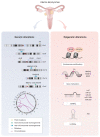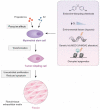Molecular and Cellular Insights into the Development of Uterine Fibroids
- PMID: 34445194
- PMCID: PMC8395213
- DOI: 10.3390/ijms22168483
Molecular and Cellular Insights into the Development of Uterine Fibroids
Abstract
Uterine leiomyomas represent the most common benign gynecologic tumor. These hormone-dependent smooth-muscle formations occur with an estimated prevalence of ~70% among women of reproductive age and cause symptoms including pain, abnormal uterine bleeding, infertility, and recurrent abortion. Despite the prevalence and public health impact of uterine leiomyomas, available treatments remain limited. Among the potential causes of leiomyomas, early hormonal exposure during periods of development may result in developmental reprogramming via epigenetic changes that persist in adulthood, leading to disease onset or progression. Recent developments in unbiased high-throughput sequencing technology enable powerful approaches to detect driver mutations, yielding new insights into the genomic instability of leiomyomas. Current data also suggest that each leiomyoma originates from the clonal expansion of a single transformed somatic stem cell of the myometrium. In this review, we propose an integrated cellular and molecular view of the origins of leiomyomas, as well as paradigm-shifting studies that will lead to better understanding and the future development of non-surgical treatments for these highly frequent tumors.
Keywords: biomarkers; genetics/epigenetics; steroid hormones; targetable pathways; tumor bulk/single-cells; tumor-initiating cell; uterine leiomyoma.
Conflict of interest statement
C.S. is the Founder and Head of the Scientific Advisory Board of Igenomix. The remaining authors declare no conflict of interest.
Figures




References
Publication types
MeSH terms
LinkOut - more resources
Full Text Sources
Medical

